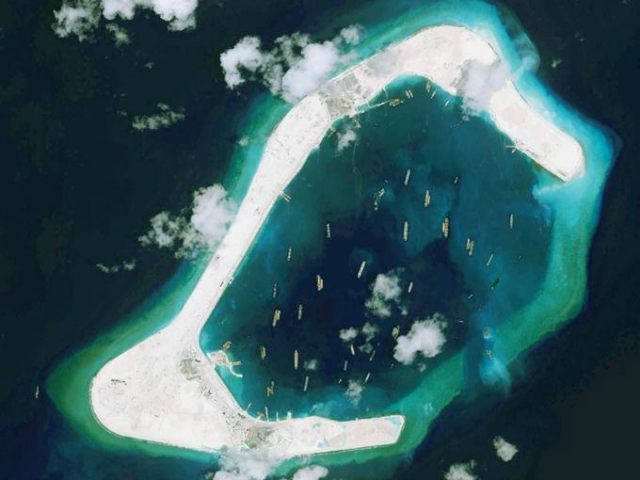A Chinese Defense Ministry spokesman denied the existence of Chinese-made artificial islands in the South China Sea on Thursday, a bizarre development given the open construction of such islands and promotion of their newly-installed assets in Chinese media.
“There is no such thing as man-made islands,” ministry spokesman Wu Qian said at a press conference Thursday, according to Reuters. He nonetheless acknowledged the existence of Chinese constructions in the Spratly and Paracel islands, arguing, “most of the building is for civilian purposes, including necessary defensive facilities.”
The Chinese state media outlets who covered Wu’s statements focused on his call for deeper ties between the Chinese and American militaries, not mentioning the remarks about the islands. “Development of China-U.S. military-to-military relationship is in line with the common interests of both countries, and is conducive to peace and stability in the Asia-Pacific region and the world at large,” Wu said of the topic.
China claims nearly all territories in the South China Sea, including sovereign territory belonging to the Philippines, Brunei, Vietnam, and Malaysia, and territory belonging to Taiwan, which China does not recognize as a sovereign state.
For the past three years, the Chinese government has invested heavily in dredging to create artificial islands out of reefs in the Spratly and Paracel Island chains, placing military assets on these islands. The most recent report by the Center for Strategic and International Studies (CSIS), published this week, shows significant development on Subi, Mischief, and Fiery Cross Reefs in the Spratly Islands. These now boast landing strips for combat aircraft, advanced radar facilities, and the capacity to hold missiles and other weaponry.
Wu’s remarks Thursday appear to reject defining the three reefs in question as “artificial islands,” despite their inability to hold such assets before the dredging projects began.
International law prohibits nations from building artificial islands and claiming them as sovereign territory, with “exclusive economic zones” in the surrounding waters. The United Nations Convention on the Law of the Sea (UNCLOS) explicitly states, “Artificial islands, installations and structures do not possess the status of islands. They have no territorial sea of their own, and their presence does not affect the delimitation of the territorial sea, the exclusive economic zone or the continental shelf.”
Reefs, in contrast, may be claimed: “In the case of islands situated on atolls or of islands having fringing reefs, the baseline for measuring the breadth of the territorial sea is the seaward low-water line of the reef, as shown by the appropriate symbol on charts officially recognized by the coastal State.”
Accepting the formations as “artificial islands” and not “reefs” may then weaken China’s argument that Beijing is entitled to an exclusive economic zone in the surrounding waters. UNCLOS provides that any waters within 12 nautical miles of sovereign territory are the exclusive economic zone of a country, allowing them the privileges of development that come with its domestic territory.
Whether the Chinese government is interested in toeing the UNCLOS line has never been clear, particularly after the June 2016 arbitration decision denying their claims to the region. The Permanent Court of Arbitration at the Hague found in the case Philippines v. China that none of China’s claims in the South China Sea were supported by international law, and thus China should cease its constructions and exit the area. The Chinese government announced it would disregard the ruling entirely, and the newly-installed government of Philippine President Rodrigo Duterte has done little to challenge China in the Spratlys.
“China’s construction activities in the South China Sea are fundamentally different from the ‘artificial islands, installations and structures’ defined in the Law of the Sea,” a column published shortly after the Hague ruling at the state-run People’s Daily argued. “They are conducted on natural features as part of the Nansha [Spratly] Islands, mainly for civilian purposes and without causing environmental damage… In accordance with international law, China’s sovereignty over the Nansha Islands also covers its components and various natural features and related waters.”
Yet some People’s Daily articles have referred to the structures in the region as “artificial islands” when mentioned in passing and not in an argument about Chinese sovereignty there.
Chinese Foreign Ministry spokeswoman Hua Chunying made a similar argument to that in the People’s Daily piece on Tuesday, responding to the CSIS report: “China’s purpose to construct facilities on its own territory is to improve the living and working conditions for the personnel stationed there, to better defend its sovereignty, to strengthen the capacity of relevant islands and reefs for providing civil and international public services, and to allow China to better perform its international obligations.”

COMMENTS
Please let us know if you're having issues with commenting.